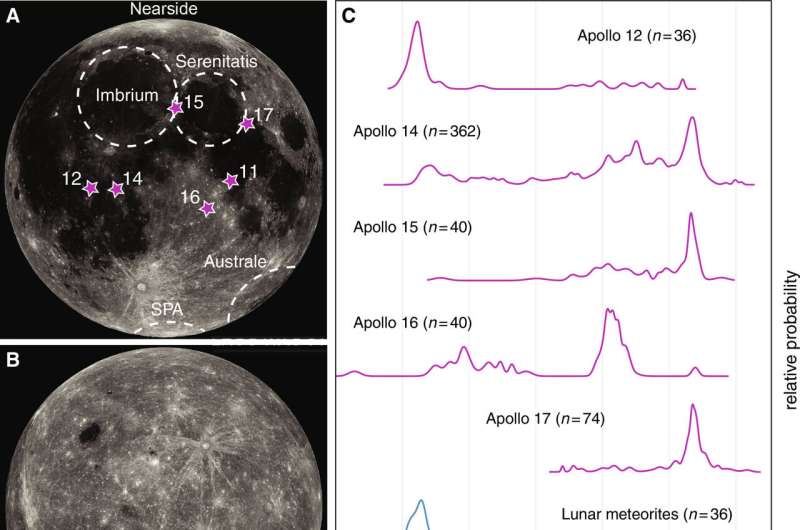July 25, 2024 report
This article has been reviewed according to Science X's editorial process and policies. Editors have highlighted the following attributes while ensuring the content's credibility:
fact-checked
peer-reviewed publication
trusted source
proofread
Geoscientists narrow timing of enormous 'magmatic event' on the moon more precisely

A team of geoscientists affiliated with several institutions in the U.S. and Switzerland has more precisely dated an enormous "magmatic event" that occurred on the moon several billion years ago.
In their study, published in the journal Science Advances, the group dissolved and analyzed zircon samples found in rocks brought back to Earth by astronauts during the Apollo space program and what they learned by doing so.
Prior research has shown that a large and dramatic magmatic event occurred on the moon more than 4 billion years ago. It is not known what caused the event, but many in the field have speculated that it was likely due to a very large impact, possibly the one that resulted in the creation of the South Pole-Aitken basin.
Prior efforts to date the magmatic event have led to an estimation of 4.33 billion years ago. In this new study, the research team made an even more precise estimate.
Minerals have been used by scientists for geochronological dating for many years because they are impacted by magmatic events and retain the changes for long periods of time. For dating events on the moon, scientists have looked to zircon, a mineral found in many of the rocks on the moon's surface. Several such rocks were returned to Earth by astronauts who collected them from the moon's surface in the late 1960s and early 1970s. Analysis of such rocks is typically done using mass spectrometry.
For this new study, the research team took a new look at some of the returned lunar rocks with an approach that had not been used before because it is destructive—they dissolved some of the zircon in several samples, allowing testing of the degree of magmatism in their interiors and surfaces.
They were able to more precisely date the magmatic event to 4.334 to 4.338 billion years ago. They also found that the event was singular, showing that it was not due to a cascade of small objects striking the moon.
The findings by the team add credence to the theory that the magmatic event was caused by a large body colliding with the moon, most likely the one that created the South-Pole-Aitken basin.
More information: Mélanie Barboni et al, High-precision U-Pb zircon dating identifies a major magmatic event on the Moon at 4.338 Ga, Science Advances (2024). DOI: 10.1126/sciadv.adn9871
Journal information: Science Advances
© 2024 Science X Network





















